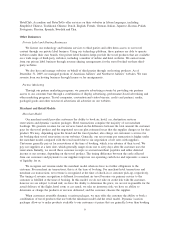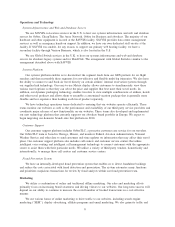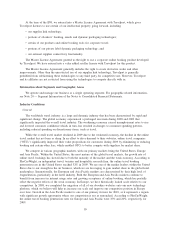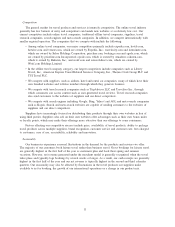Orbitz 2010 Annual Report Download - page 16
Download and view the complete annual report
Please find page 16 of the 2010 Orbitz annual report below. You can navigate through the pages in the report by either clicking on the pages listed below, or by using the keyword search tool below to find specific information within the annual report.• the financial condition of suppliers, including the airline and hotel industry, and the impact of their
financial condition on the cost and availability of air travel and hotel rooms;
• changes to regulations governing the airline and travel industry;
• fuel prices;
• work stoppages or labor unrest at any of the major airlines or airports;
• increased airport security that could reduce the convenience of air travel;
• travelers’ perceptions of the occurrence of travel related accidents or the scope, severity and timing of
the other factors described above; and
• changes in occupancy and room rates achieved by hotels.
If there is a prolonged substantial decrease in travel volumes, particularly for air travel and hotel stays,
for these or any other reasons, it would have an adverse impact on our business, financial condition and results
of operations.
We carry significant goodwill and indefinite-lived intangible assets on our consolidated balance sheets, and
if a future impairment were to occur based on a decline in our stock price, projected results of operations,
cash flows from operations or otherwise, we may be required to record a significant charge against
earnings.
During the years ended December 31, 2009 and December 31, 2008, in response to changes in the
economic environment and the prolonged decline in our market capitalization, we recorded non-cash
impairment charges of $250 million and $210 million, respectively, related to our goodwill and $82 million
and $74 million, respectively, related to our indefinite-lived intangible assets. As of December 31, 2009, after
giving effect to these impairment charges, we had goodwill and indefinite-lived intangible assets of
$868 million, which represented approximately 67% of our total consolidated assets. Under generally accepted
accounting principles, goodwill and indefinite-lived intangible assets must be tested for impairment annually
or more frequently whenever events occur and circumstances change indicating potential impairment. Factors
that could indicate that our goodwill or indefinite-lived intangible assets may be impaired include a prolonged
decline in our stock price and market capitalization, lower than projected operating results and cash flows and
slower growth rates in our industry. Due to the current economic uncertainty and other factors, we cannot
predict whether our goodwill and indefinite-lived intangible assets will be further impaired in future periods or
whether a significant charge against our earnings may be required, which could be higher than the charges
recorded during 2009 and 2008. If we are required to record an impairment charge for our goodwill and
indefinite-lived intangible assets in the future, this would adversely impact our results of operations.
We have a significant amount of indebtedness, which could limit the manner in which we operate our
business.
As of December 31, 2009, we had approximately $619 million of outstanding borrowings under our
senior secured credit agreement, which was reduced to $527 million as a result of the debt-equity exchange
we completed with PAR and the repayment of outstanding borrowings on our revolving credit facility in
January 2010. Our substantial level of indebtedness could result in the following:
• it may impair our ability to obtain additional financing for working capital, capital expenditures,
acquisitions or general corporate purposes;
• it reduces the funds available to us for purposes such as potential acquisitions and capital expenditures
because we are required to use a portion of our cash flows from operations to make debt service
payments;
• it puts us at a competitive disadvantage because we have a higher level of indebtedness than some of
our competitors and reduces our flexibility in planning for, or responding to, changing conditions in the
economy or our industry, including increased competition; and
16
























